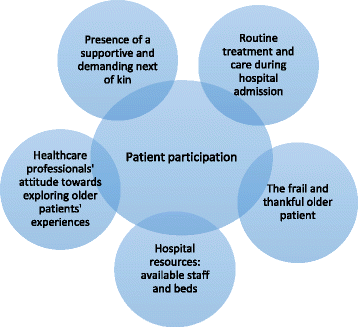Older patients' participation in hospital admissions through the emergency department: an interview study of healthcare professionals
- PMID: 26486306
- PMCID: PMC4617984
- DOI: 10.1186/s12913-015-1136-1
Older patients' participation in hospital admissions through the emergency department: an interview study of healthcare professionals
Abstract
Background: Patient participation is an important aspect of healthcare quality and may be one way to improve the quality of transitional care for older patients. Research reveals minimal awareness about patient participation in hospital admissions. Hospital admissions require attention to individuals' specific needs beyond patient frailty, and to involve patients and their families in shared decision-making. The aim of this study was to identify factors influencing patient participation by exploring healthcare professionals' views on patient participation during the hospital admission of older patients through the emergency department (ED).
Methods: The study used a qualitative and descriptive design with face-to-face interviews. A total of 27 interviews were conducted with 15 healthcare professionals from one hospital and 12 from another. The data were analyzed using systematic text condensation.
Results: Healthcare professionals thought that patient participation in hospital admissions was influenced by five main factors: 1) routine treatment and care during hospital admission, and in particular certain procedures such as medical examinations; 2) the frail and thankful older patients, and the overall picture of their medical needs; 3) hospital resources, such as available staff and beds; 4) healthcare professionals' attitude towards finding out about older patients' experiences; and 5) the presence of a supportive and demanding next of kin acting as an advocate for the patient.
Conclusions: Patient participation in hospital admissions of older patients is dependent on the way the service is organized, the patients' condition, hospital resources, healthcare professionals' attitudes, and support from patients' next of kin. Some of the participants had high expectations of themselves and actively involved patients, but others did not find patient participation relevant in the emergency department. Some used crowded wards as a reason not to engage older patients in their own care.
Figures
References
-
- Institute of Medicine . Crossing the quality chasm: a new health system for the 21st century. 2001. - PubMed
-
- National Directorate for Health and Social Affairs . …and it’s going to be better! - National strategy for quality improvement in health and social services (2005–2015), Norwegian Directorate for Health and Social Affairs. Oslo: Directorate for Health and Social Affairs; 2005.
-
- Norwegian Ministry of Health and Care services. The coordination reform. Proper treatment - at the right place and right time. Directorate for Health and Care Services, 2008–2009. Oslo: Norwegian Ministry of Health and Care Services; 2009.
Publication types
MeSH terms
LinkOut - more resources
Full Text Sources
Other Literature Sources


